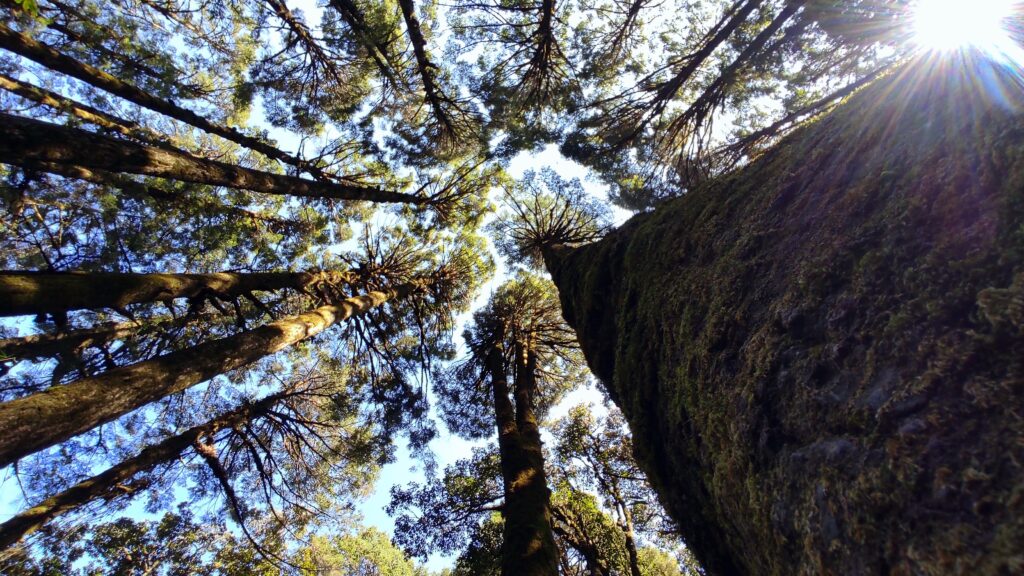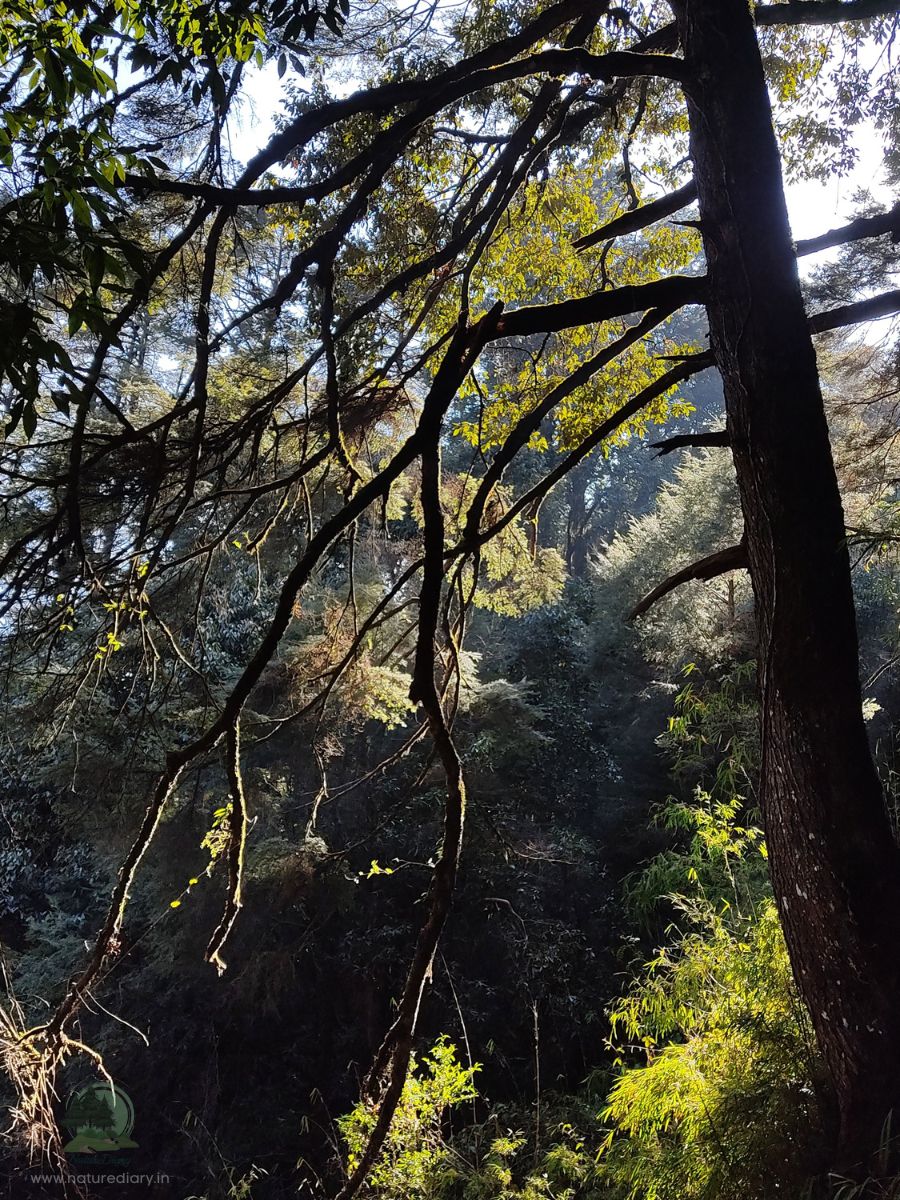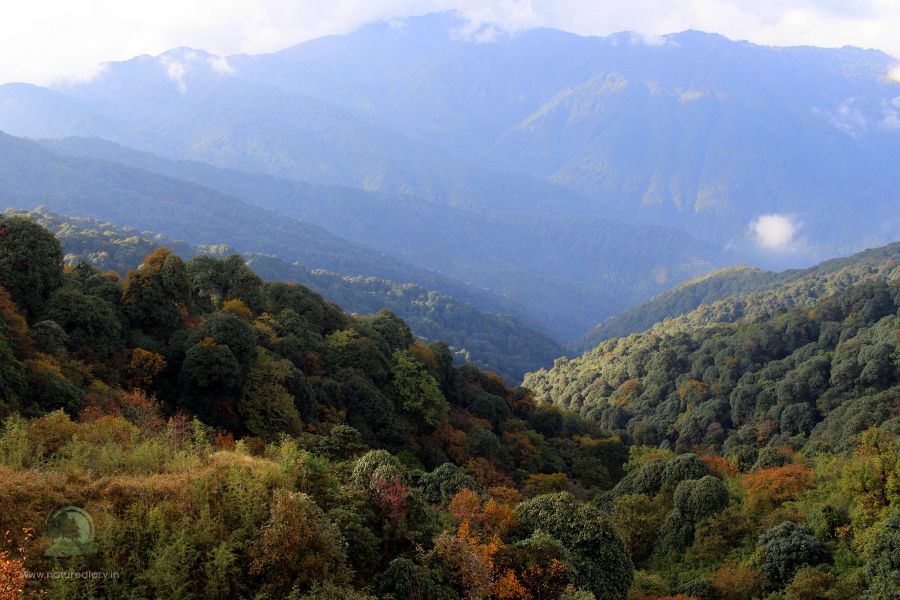The Singalila National Park is a reserve forest that hosts some of the most exotic and rarest Himalayan flora and fauna. Nested between West Bengal, Sikkim, and Nepal at an elevation spanning between 7,900 ft. and 12,000 ft., it entrances travellers and trekkers alike.
Currently, Singalila National Park is one of the few places on earth where you can still find endangered species like the red panda and the clouded leopard. Interestingly, the highest peak of West Bengal, Sandakphu, lies in this national park.
Back in January, I feasted my eyes on the lustrous view of the elegant Kanchenjunga range, along with the entire Sleeping Buddha and Mount Everest. It was my first encounter with mountainous forest trails and my first trek that changed my outlook on life.
Whether you are an adventure enthusiast, nature lover, or wildlife photographer, you cannot help standing and pampering your vision with so pleasant a view. Singalila National Park brings the scenic beauty and raw charm of the Eastern Himalayas to mesmerize travellers.
If you are a trekker, think about exploring 78.60 square kilometres of rhododendron forests and pine-clad valleys, where no motorways can access. I will tell you why Singalila National Park continues to be the birders’ paradise, the trekkers’ focal point, and travellers’ dream destination.

History Of Singalila National Park
It was back in 1882 that the British Government bought the Singalila forest from the King of Sikkim. After India gained its independence, the forest became a wildlife sanctuary under the Darjeeling district of West Bengal in 1986. Six years later, in 1992, Singalila was declared a national park.
Besides housing some high-altitude peaks like Sandakphu and Phalut (both close to 12,000 ft.), the Singalila ridge remains enveloped by dense vegetation. Naturally, trekkers visiting Sandakphu and Phalut make their way through the pine thickets as well as the undulating rocky stretches.
During my trek, I found dense, lush green vegetation of rhododendron, oak, and bamboo thriving in the forest. Interestingly, the celebrated occultist Aleister Crowley and Jules Jacot-Guillarmod led a mountaineering team through this trek back in 1905. Although their attempt to scale Mount Kanchenjunga failed, the documentation serves as a testimony of the ancient trail running between the evergreen forest.
Singalila National Park Map
Attractions And Activities At Singalila National Park
Before I visited Singalila National Park, I heard many interesting stories. My 7-day trek to Sandakphu nurtured my affinity with the mountains as I savoured different attractions and activities at Singalila National Park. The next time you plan a trip to this reserve forest, take advantage of all these activities.
Immerse Yourself In The Nature
Being a nature lover, I couldn’t help wandering into the woods and moving away from the main trail during my Sandakphu trek. Even the down-trek trail that passes through the thickets of Gorkhey remains dominated by alpine and temperate vegetation.
Well, when your yearning for a break grows too strong to resist, venture into the rhododendron, oak, and bamboo forests. The Singalila ridge remains covered by exotic plant species like Senecio, Cotoneaster, Primula, Geranium, Saxifraga, Bistort, and Magnolia. If you plan a forest safari or trek in March or April, you will find more than 20 types of rhododendrons in different hues enthralling your view.

Besides, you have more than 600 species of ornamental primulas and orchids that refine the panoramic bliss in the silent forest. Singalila National Park has a gravel road connecting different places. Well, you can get caught in time and never know how the captivated moments tick away in the forest.
Watch Birds And Wildlife
If you love birdwatching, Singalila National Park won’t disappoint you. The forest has more than 390 bird species, which include six globally threatened species. It continues to be one of the most frequented birding spots in Eastern India, particularly during the blooming season.
The unique Himalayan ecosystem hosts bird species like fire-tailed myzornis, blood pheasants, Himalayan griffons, satyr tragopans, brown parrotbill, black-throated parrotbill, cuckoo, robin, and brown parrotbill.

For birders and nature lovers, Singalila National Park brings the best opportunity to watch exotic Indo-Burma species as well as the high-altitude birds of the Himalayas. Although you won’t need any special permit to catch a glimpse of these birds, some non-designated trails do exist, for which you need to get permission from the forest officials.
If you are someone who loves swearing by your long lens, you would go to any length to catch the amazing flocks. Plan your visit in Singalila National Park between November and March for the best birdwatching opportunities. Watch this video to see the magnificent birds inside the park.
Apart from birds, the stretch between Singalila and Tinchuley still has around 32 red pandas, the extremely elusive species of India. Other animals to be spotted in the Singalila National Park include the leopard cat, clouded leopard, the Himalayan Black Bear, barking deer, Himalayan Serow, wild boar, Yellow-throated Marten, pika, and pangolin. Among the rare lizards, the forest houses the Himalayan Newt.

There are no watchtowers in the forest, leaving trekkers and visitors exposed to the raw charm of nature. To captivate yourself with the biodiversity of Singalila National Park, you have only the gravel path and trail. Venturing into the forest can be dangerous, given that steep gorges remain concealed under dense vegetation. So, you must hire a guide and get permission.
Engage In Travel Photography
Travel photographers cherish every moment at Singalila National Park. Whether it’s the elusive red pandas or wafting clouds along the high-altitude peaks, you always have wallpaper shots to capture. Well, I consider myself fortunate to experience both snowfall and a clear sky at Sandakphu on back-to-back days.
While ascending Sandakphu, we encountered heavy snowfall. Our spirits dampened as there was merely any chance to see the Sleeping Buddha Peaks the next morning. Even the caretaker of the GTA Lodge at Sandakphu said that unless there’s a miracle overnight, we will miss out on the blissful view.
AND THE MIRACLE DID HAPPEN! The next morning, I heard the excited voices of trekkers outside our window. The sun had risen, and the entire range of the Kanchenjunga was dazzling in a golden hue. We were lucky to photograph Mount Everest, Lhotse, Kanchenjunga, and Makalu, along with Three Sisters. From the same spot, we could see other peaks of Bhutan, Nepal, Tibet, and Sikkim!

So, if you love to photograph or make vlogs of the mountains and nature, Singalila National Park won’t disappoint you. The variety of natural vegetation along the Singalila Ridge looks fascinating, ranging from coniferous to tropical pine. How about playing peek-a-boo with the rare animal species or chance your lens upon the clouded leopard?
Sandakphu-Phalut Trek
Well, if you are a trekker, nature lover, as well as a photographer, I highly recommend going on the Sandakphu-Phalut trek. Even beyond Sandakphu, the downhill trek through the forested stretches of Singalila National Park on the other side of the mountain would give you thrilling moments.
The stretch between Sandakphu to Phalut is the most popular, as it opens up incredible views of the Kanchenjunga range. You have seasonal wildflowers, birds, and camping sites along with the forests and mountains. This trek begins at Manebhanjan, around 51 Km from Darjeeling, and you have accommodation facilities at regular intervals.
Our trip included overnight stays at Dhotrey, Tumling, Kalipokhri, Sandakphu, Sabargram (7 km From Phalut), Gorkhey, Gurdum and Srikhola that mostly lie inside Singalila National Park.
Living accommodations are available at the GTA Lodges and homestays, while you need to hire guides to explore the forest. You can hire guides from any of the trek’s entrance points, including Manebhanjan, Dhotrey, and Rimbick.
The picturesque trails make trekking to Sandakphu a popular activity in Singalila National Park. If you are planning to visit, mark your calendar from September to April and this is the perfect time to take on this trek. In April, the orchids and rhododendrons remain in full bloom, illuminating the forest trail with its natural wonders.
Go On A Jeep Safari
Well, during my trip to Singalila National Park, I found many tourists enjoying their jeep safari at Singalila National Park. If trekking isn’t your cup of tea, and you dislike straining your muscles, why not take a ride on the vintage British-era Land Rover Cars?
The Jeeps and, recently, Boleros take the gravel path that intersects the trekkers’ trail at several places. However, jeeps cannot access the deep forests due to safety concerns and the presence of steep gorges. At Manebhanjan, you can rent a Land Rover or arrange a Jeep safari by consulting your tour operator.
The gravel path winds through the lofty pine forests and rugged boulders. Far at a distance, you can catch glimpses of the local villages of the Gorkha community as you scale the highest peak of West Bengal. The gravel path passes through Tumling, Kalipokhri, and Sandakphu right up to Phalut. The Land Rover Association charges ₹3,000 for the Safari.

Enjoy A Blissful Camping
While the trek route through Singalila National Park right up to Phalut and then the down trek is ideal for beginners, you have the ideal opportunity to start camping here. It was during my accommodation at the GTA Trekkers Hut at Tonglu that we shared our dormitory with two campers. They didn’t book any accommodation at Kalipokhri and Sandakphu. Rather, they were out camping amidst the wilderness around the national park.
For camping, you need to get permission at the Check Post at Manebhanjan for a fee. The forest authorities charge the fee depending on the number of gear you carry, the number of camping tents, where you would be camping, and other aspects. Even on the way to Phalut, you will come across several places to pitch your tent.

How Can You Reach Singalila National Park?
Singalila National Park is well-connected to the nearest town through roadways. Besides, trekkers and travellers find easy exit points throughout the journey.
- Air Services: At Bagdogra, you have an international airport. From this point, it takes four hours to reach the national park by car. Renting a car will cost you around ₹3,500.
- Train Services: The nearest railway station is at New Jalpaiguri, around 85 Km away from Manebhanjan. You can hire a shared car or rent one from the station itself. The trek starts at Manebhanjan, although you can take your car up to Dhotrey. Renting a car will cost you anything between ₹3,500 and ₹4,000.
- Roadways: Apart from NH 27, which connects this area to Delhi, you can reach Singalila National Park from all major cities in West Bengal. I came across several visitors from Darjeeling, located 50 kilometres away. Shared cars from Darjeeling charge around ₹200–300 to reach Manebhanjan.
- Entry Fee: We had to shell out a minimal amount of ₹100 to enter Singalila National Park. For foreigners, the forest authorities charge ₹200 as the entry fee. You need to pay for this at the office at Manebhanjan. If you decide to get a Land Rover, it would cost you ₹4,800, apart from the night halt charge.

The Best Places To Visit In Singalila National Park
Singalila National Park houses some of the most scenic mountains, valleys and forests. We have explored many tourist destinations in North Bengal, but there is no match for this beautiful forest with incredible flora and fauna. Here are the must-visit places in the national park for a lifetime.
Dhotrey
Dhotrey is a small hamlet located 20 odd kilometres from Manebhanjan. For many trekkers, the starting point of the Sandakphu trek is Dhotrey. There are a few homestays around this place, clad with pine forests. You can also take your guides and porters from Dhotrey if you plan a trek.
Tumling
Located 4 Km from Dhotrey at an elevation of 9,600 feet, Tumling is one of the most picturesque areas in Singalila National Park. There’s a concrete path passing through this region. Personally, I spend some time in the viewpoint at this stretch, capturing the Himalayan peaks. The trek route from Dhotrey to Tumling takes around 5 hours.
Tonglu
At an elevation of 10,130 feet, Tonglu is a scenic tourist attraction that lies a little away from Tumling. Last time, I stayed overnight at the GTA Trekkers’ Hut at Tonglu after trekking all the way from Dhotrey. In winter, you can catch the awe-inspiring beauty of snowflakes covering the alpine vegetation around the place. In other seasons, the pristine waters of the lake in front of the GTA Trekker’s hut reflect the red structure with vibrant shades.
Kalipokhri
It lies further uphill from Tumling, at 10,400 feet. Kalipokhri is a small village, famous for its black lake, with some private accommodations and a GTA lodge. Trekkers generally take a halt at this place after a stiff ascend of 13 Km from Tumling.
Sandakphu
Well, if you are visiting Singalila National Park, it would be a sin to miss out on Sandakphu Peak. At an elevation of 11,930 feet, it is the highest peak in West Bengal. In January, when I was here, temperatures at night dipped below -7°C. I could see icicles hanging from the cottage sheds and kitchen!
Phalut
At 11,811 feet, Phalut is the second-highest peak in West Bengal. However, you can actually get a closer look at the mighty Himalayan ranges from Phalut since it is located further north of Sandakphu. It takes a day’s trek to reach this place, where you can find accommodation at GTA lodges and a few homestays.
Gurdum
A serene hamlet strategically lying between Sandakphu and Srikhola, Gurdum remains surrounded by dense forests. You have thick rhododendron groves and lush alpine forests of the Singalila National Park in Gurdum.
There are hardly 15 families residing in the tiny settlement. So, if you are looking for offbeat places in North Bengal, you can plan your trip to Gurdum. Stargazing and birdwatching are some of the most popular activities in this little settlement in the forest.
Gorkhey
Gorkhey is a scenic trekking attraction, known for its dense forests and steep downhill trails through the thickets. It lies 15 Km from Phalut and is one of the focal points of several trek routes radiating to Photkey Dara, Phalut, Hilley, Varsey, and Okhre. However, you won’t find a motorable road here, which leaves trekking the only option to reach the GTA lodge in Gorkhey.
Srikhola
We finally ended our trip to Singalila National Park at a small hamlet Srikhola, which has access to roads connecting to Rimbik and Darjeeling. Srikhola is yet another picturesque settlement deep inside a valley.
The mighty Srikhola river thunders sonorously just behind the GTA lodge and Hotel Shovraj. It was mesmerizing to hear the water making music all through the night right outside my attic window!
Srikhola is also a great place for birdwatching, where Soumya, my co-author and photographer on NatureDiary captured some magnificent photos of Himalayan birds.

When Should You Visit Singalila National Park?
I recommend two seasons to explore Singalila National Park. From March to May, you have the blossoms defining the mystic charm of the forest at the peak of spring. This season will enthral you with the beauty of wildflowers, orchids and rhododendrons.
Also, you have autumn and winter from October to February, where you can enjoy snowfall in the Himalayan alpine forests. The park remains closed from June to September due to heavy rainfall.
If you love trekking like me, plan a 5-6 days trek from Manebhanjan to Srikhola via Sandakphu. However, if you want to enjoy the jeep rides, a 2N/3D trip would be enough for you.
